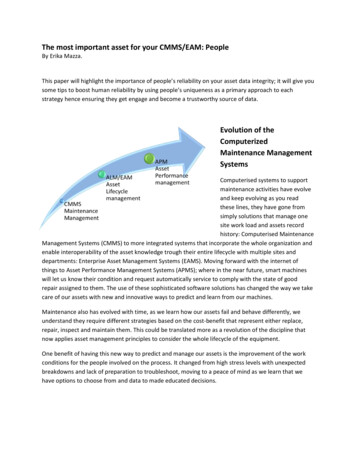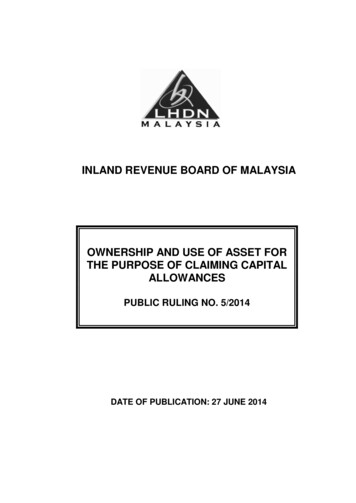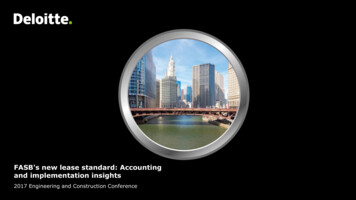
Transcription
The most important asset for your CMMS/EAM: PeopleBy Erika Mazza.This paper will highlight the importance of people’s reliability on your asset data integrity; it will give yousome tips to boost human reliability by using people’s uniqueness as a primary approach to eachstrategy hence ensuring they get engage and become a trustworthy source of data.Evolution of theComputerizedMaintenance ManagementSystemsComputerised systems to supportmaintenance activities have evolveand keep evolving as you readthese lines, they have gone fromsimply solutions that manage onesite work load and assets recordhistory: Computerised MaintenanceManagement Systems (CMMS) to more integrated systems that incorporate the whole organization andenable interoperability of the asset knowledge trough their entire lifecycle with multiple sites anddepartments: Enterprise Asset Management Systems (EAMS). Moving forward with the internet ofthings to Asset Performance Management Systems (APMS); where in the near future, smart machineswill let us know their condition and request automatically service to comply with the state of goodrepair assigned to them. The use of these sophisticated software solutions has changed the way we takecare of our assets with new and innovative ways to predict and learn from our machines.Maintenance also has evolved with time, as we learn how our assets fail and behave differently, weunderstand they require different strategies based on the cost-benefit that represent either replace,repair, inspect and maintain them. This could be translated more as a revolution of the discipline thatnow applies asset management principles to consider the whole lifecycle of the equipment.One benefit of having this new way to predict and manage our assets is the improvement of the workconditions for the people involved on the process. It changed from high stress levels with unexpectedbreakdowns and lack of preparation to troubleshoot, moving to a peace of mind as we learn that wehave options to choose from and data to made educated decisions.
CMMS/EAMS by the People, for the PeopleEven though we are entering the era of IIoT and smart machines the reality is that most organizationsare using CMMS or EAMS, where more than 95% of the data come from human interaction.It is people like the System Administrator who will configure the master data and keep it up-to-date;Maintenance Managers will add maintenance plans, asset attributes, BoM and even set the thresholdfor machine connectivity and regular Users will request service based on their observations of how themachine is performing.Then a very important trio (Planner, Stock Manager and Workforce) will complete the work flow processadding additional data and completing the asset historical record thru planning of work orders,managing parts and recording activity results, failure data and meaningful closing comments. These treeroles are key players on enriching the asset history and keeping up-to-date the existing data, based ontheir feedback. They are the closest to the assets and they are the ones who can identify opportunitiesfor improvements or issues that require attention, they can update asset condition and name plates andeven help optimized existing PM programs.Managers at all level of the organization will then rely on this data and create reports to make decisions,adjust priorities and understand asset performance. But an important question arises: is the Data fit forits intended uses in operations and maintenance decision making?
Five characteristics of high quality data are accuracy, completeness, consistency, relevance, andtimeliness.Data needs to be accurate to be useful. The entries input into a data base is presumed to be perfect aswell as accurate, therefore the information that is accessed is deemed reliable. Accurate data will helpreduce your response and decision-making time. When you trust your data, you can use the system asan one stop center to define requirements, order parts, schedule work and maximized your teamefficiency.Completeness is another attribute of high quality data. Partial data may as well be incompleteinformation because it is only a small part of the picture. Completeness is as necessary as accuracywhen relaying on your software to make decisions.Consistency is key when entering data. Fields can be set to specific data characteristic to ensureconsistency, fields that are not set to a specific value requires a robust set of standard businessprocesses that spell out the format and syntaxes of the data entry. These attributes also enableinteroperability of the information and knowledge sharing between systems and multiple departments.Relevance is the fourth component of high quality data. The data that you record must be aligned withthe corporate strategic goals and should support the evaluation of KPIs. Information is a very essentialpart of any organization and if used properly can make company excel on competitive markets,strengthen their reputation and maximize their profits and reduce your maintenance expenses.A fifth important aspect of data is timeliness. New and current data is more valuable to organizationsthan old outdated information. Along with the other characteristics of good data quality, timelinesscontributes to effectiveness of the functionalities of your CMMS/EAM systems, allowing you to havereal-time insights on your asset and work force performance.
Human Error and Human ReliabilityThe reliability of the data isdirectly tied to the source of it. Asmentioned before our primarysource of data for all kinds ofCMMS/EAMS is people; one of themost complex assets that you canhave in your organization.People can be unpredictable, hardto reset or reprogram, easilydistracted, highly multifunctional,unique, autonomous, muddy,sensitive, etc. making themprompt to commit errors that will compromise the integrity of your asset data in the CMMS/EAMS.Fortunately, errors are the outcome of multiple human and organizational factors happening on a chainreaction. The human factor link is a physiology combination of: decision, learning, performance,omission and memory. We could break out the organizational factors (environment and task) into:systems, procedures, processes and culture. Organizational factors will give us a chance to influence thehuman link and break the error chain.Avoiding blaming people but focus on the possible contributing factors of the problem will help youidentify practical solutions; one way to do this is by categorizing the type of human errors that promptsituations like missing failure data on work orders, logging unrealistic labor hours or even choosing thewrong asset to track the history. Using Root Cause Analysis and other strategies will identify what is theultimate cause of the define human error helping you to build strategies that prevent the occurrenceand reoccurrence of the human errors when inputting data into the CMMS/EAMS and boost the humanreliability.We can influence behaviors and outcomes by ensuring there is a platform that enables humanreliability, when deploying a new system, re-lunching existing systems or sustaining operations of yourcurrent CMMS/EAMS.Some strategies include efficient ergonomics; practical process and systems; a variety of training, clearcommunication and motivational ideas to engage and promote sense of ownership on our so complexhuman capital and primary source of data.
These strategies could lead youto a great success but only ifthey are built keeping in mindthe PEOPLE and theircharacteristics.Human assets are very complex,no one is identical to any other,more over the level ofinteraction with theCMMS/EAMS and expectationsof it are different, thereforeeach of these strategies shouldbe molded to their role as muchas possible.Ergonomics: software developers have this critical enabler in mind as systems are develop more userfriendly, intuitive and with more options to configure screen and software interfaces as per the userspreferences and roles, here are some ideas you can implement to make sure ergonomics are moreeffective: Design system’s work environment with meaningful information and dashboards according toeach role. Hide any application of the system that your users have not access or it is notrequired to do their job. Ensure availability of hardware /devises for your users to input their data. Provide them with anadequate work space (clean/ventilate desk, comfortable chairs or high quality connectivity forhand held devises) and top of the line hardware. Configure electronic systems (alerts, warnings, etc.) to help staff to stay focus.Processes and systems: review and update constantly your SOPs and work instructions as part ofcontinuous improvement process. A business process to include feedback and people’s knowledge intooptimizing and updating these processes must be in place to capture, validate and implement changesthat enable people to know what, when and how to input accurate and complete the data in theCMMS/EAM. Pay attention to the following: SOPs, Documents, work instructions should list any specific data to be recorded on the systemor sub sequent actions to be taken to modify update and /or add a new record. Create activitysequence and/or check lists for those tasks that require data entry. Highlight inputting the datain the CMMS/EAMS as one of the steps. Quick reference and user manuals made simple; more pictures less letters
Role and responsibilities must be defined with clear expectations on how they will interact withthe system. When the users know the scope of their work with the CMMS/EAMS, it is lessoverwhelming and ensures accountability. Reduce interruptions and distractions during procedure executions to keep people focus ontheir task. Allow time for data entry; some of the roles are more complex than others, executingmultiple tasks at the same time, but if you want to ensure the right data gets input, they need tohave a certain amount of time to do so, promoting accuracy and timeliness of the data.Training: by training people on the functionalities of the CMMS/EAMS they will be more confident touse the system, increasing their contribution, accuracy and consistency of the data, but theCMMS/EAMS software could be tremendously powerful and very overwhelming. Special considerationswhen setting up training should be taken in order to avoid disengagements due to information overload: Role based: not all users need to manage all the functionality of the system, small sessionsbased on each role’s primary tasks are more suitable. They need to master what they areexpected to do on the system, and then they could explore more if they want. Aware of cognitive load: break or simplified processes by splitting it into short step-by-steptasks. This ensure that the presentation of information does not impede learning. Consider the different learning styles (visual, kinesthetic, reading /writing, listening) include a bitof each style in your training session and support documents, so everyone can process theinformation in the way they are more comfortable with. Training beyond CMMS/EAMS: when the users of the CMMS/EAMS get familiar with conceptsthat drive the type and amount of data that is require for them to collect, they will be moreknowledgeable and accretive to record the require data.Communication: creating common meaning helps everyone understand each other. If you don’t explainwhy and what the purpose is to use a CMMS/EAMS, then people are skeptical from day one and will not(fully) cooperate.Communicate how everybody has a piece of the puzzle in the corporate big picture, preach Corporateobjectives and communicate any change that impact the type of KPIs and data drivers required tosupport the organization’s strategic plan. This alignment needs to be clearly represented on the datathat people needs to populate into the system. Change management is a key to stay up-to-date andrecord relevant/useful data.In summary: Stablish a glossary of terms, so everybody is in the same page – Semantics. Tell people what is expected of them and explain how this link to the big picture – Clearexpectations.
Keep people up-to-date of any variance on the corporate policies, procedures and priorities –Manage the changes.Motivation: this is almost an art, be aware that to effetely motivate people you need to cover theirneeds, but everybody has different needs and different priorities. Understanding these needs andensuring the basic ones are cover will allow people to focus on new goals. Identify the personality of youstaff to motivate them more effectively. There are several theories but most of them are based on 4temperaments: Melancholic /Visualizer, Choleric /Leader, Sanguine /Innovator and Phlegmatic/Supporter [Galen’s four temperamental explore more latter on by Pavlov / California PsychologicalInventory CPI260], each personality perceives and process the information in different ways andmoreover they will be motivated and engaged differently. Start with answering the question WIIFM? Showcase the benefits of using the software and theimportance of their role on recording reliable data. Prepare scenarios that demonstrate howsimple is to access accurate and complete asset history using the system and compare to theamount of effort required to do the same task without having trustworthy data on the system. Personality traits may play a role on how motivate and engage people into using the system. Recognition; there are as many effective ways to manage people to attain high performance butcertainly recognition for doing a good effort may start the wheels of engagement and motivatepeople to keep up. Display how the organization uses the data that they input into the system to make decisionsand measure performance.Sense of ownership is the ultimate prized of an engage work force and healthy workplace. It is a directresult of employees taking responsibility on a personal level as well as a team effort. Taking ownershipmeans you hold yourself accountable for your actions and how you do your job. When employees feel asense of ownership towards the duties, they tend to become better performers at work, hence morereliable source of data. Some tips to build sense of ownership for the data people input into the systemare: Promote feedback for changes of the system functionality. Give them the opportunity to tailor their start centers or CMMS/EAMS workspace screens. Emphasize it is their knowledge and expertise. Ensure the data is available to them for use and consultation. Empower them through knowledge.
Final Thoughts. Data quality comes down to 5 characteristics (completeness, accuracy, consistency, relevanceand timeliness) that must be defined and understood by every user to set clear expectations ofwhat is require of their interaction with the CMMS/EAMs.Human assets are unique; they learn, communicate and engage differently. Understandingthese characteristics and building the systems and processes with them in mind will gain foryour organization a sustainable culture that will endure, evolve and continuously improve.When dealing with human reliability for asset data integrity there are many efforts like usercentered design and error-tolerance design to make technology better suited to operation byhumans, but knowledge and communication will advance your organization to have atrustworthy primary source of data.Any piece of data you input in the system must be aligned with the organization strategic planand goals so the information that derives from your primary source – PEOPLE – will be usefuland meaningful to make educated decisions regarding your assets.As technology keeps evolving so should we, but never forget that technology is nothing withoutsmart people using it to the best of its functionality and harvesting it to get insights into ourreality.
CMMS/EAMS by the People, for the People Even though we are entering the era of IIoT and smart machines the reality is that most organizations are using CMMS or EAMS, where more than 95% of the data come from human interaction. It is people like the System Administrator who will configure the master data and keep it up-to-date;











